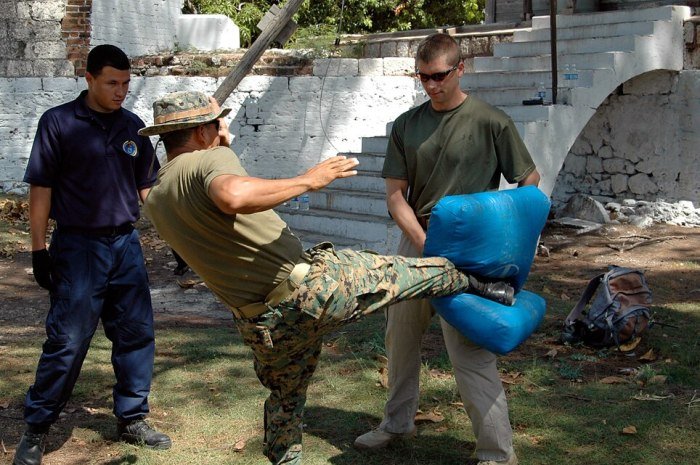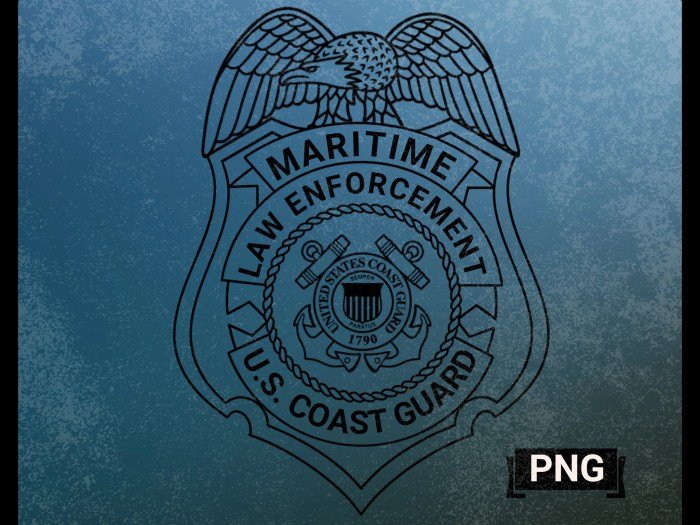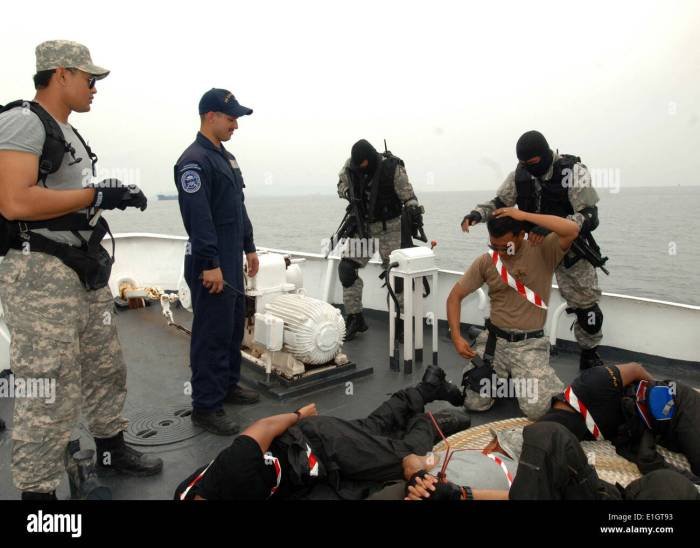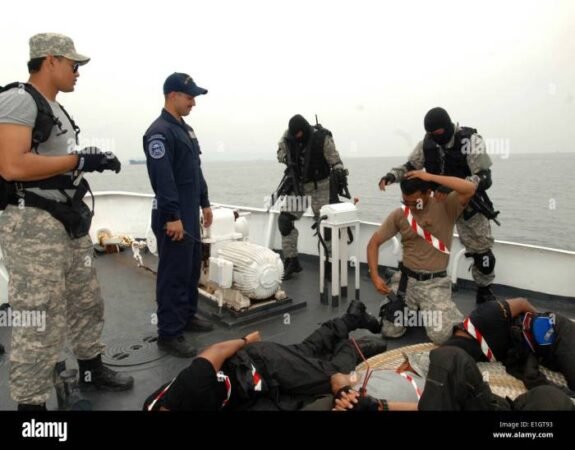
The United States Coast Guard plays a crucial role in maintaining maritime security and upholding the law on America’s vast waterways. From patrolling the open ocean to navigating intricate inland rivers, the Coast Guard’s jurisdiction extends across diverse environments, demanding adaptability and specialized expertise. This exploration delves into the multifaceted world of maritime law enforcement, examining the Coast Guard’s authority, operational procedures, the types of crimes they address, the training they undergo, and the challenges they face.
This examination will unveil the complexities of maritime law enforcement, highlighting the Coast Guard’s significant contributions to national security and public safety. We will explore the legal framework governing their actions, the technological advancements aiding their operations, and the collaborative efforts with other agencies to combat transnational crime. The challenges faced by the Coast Guard, from budgetary constraints to evolving criminal tactics, will also be addressed.
US Coast Guard Jurisdiction and Authority

The US Coast Guard possesses a broad and multifaceted jurisdiction, encompassing a wide range of responsibilities related to maritime safety, security, and environmental protection. Understanding the extent of their authority is crucial for both mariners and the general public. This section will detail the geographical reach of their power, the types of vessels they regulate, the legal underpinnings of their actions, and situations where their authority might be contested.
Geographical Boundaries of US Coast Guard Jurisdiction
The Coast Guard’s jurisdiction extends to the territorial waters of the United States, which are generally recognized as extending 12 nautical miles from the baseline. This includes coastal waters, internal waters, and ports. Beyond the territorial sea, the Coast Guard also exercises authority in the contiguous zone (extending up to 24 nautical miles from the baseline) for certain enforcement purposes, primarily related to customs, immigration, and public health. Furthermore, the Coast Guard has significant responsibilities in the Exclusive Economic Zone (EEZ), which extends up to 200 nautical miles from the baseline, concerning fisheries management, environmental protection, and other maritime activities. Their authority in international waters is often exercised in cooperation with other nations or through international agreements.
Types of Vessels Subject to Coast Guard Authority
The Coast Guard’s authority encompasses a broad spectrum of vessels, including but not limited to: commercial vessels (cargo ships, tankers, passenger vessels), recreational vessels (boats, yachts), fishing vessels, and military vessels operating within US waters. The specific regulations and enforcement actions vary depending on the type of vessel, its size, and the nature of its operation. Even seemingly small recreational vessels are subject to safety regulations and can face Coast Guard intervention for violations.
Legal Basis for Coast Guard Enforcement Actions
The Coast Guard’s authority is derived from various federal laws and treaties. Key legislation includes the Coast Guard Authorization Act, the Ports and Waterways Safety Act, and various environmental protection laws. These statutes grant the Coast Guard broad powers to board vessels, conduct inspections, enforce safety regulations, investigate accidents, and take other actions to ensure maritime safety and security. International treaties and conventions also play a role, particularly in areas like search and rescue and combating illegal activities at sea.
Examples of Challenges to Coast Guard Authority
Challenges to Coast Guard authority can arise in several contexts. Disputes may occur over the interpretation of maritime boundaries, the scope of enforcement powers in specific situations, or the legality of particular actions taken by Coast Guard personnel. Legal challenges may be brought before federal courts, involving issues such as due process, the use of force, and the admissibility of evidence obtained during boardings. For example, a vessel owner might challenge a seizure based on a claim that the Coast Guard lacked probable cause or that their actions violated constitutional rights. International disputes can also arise, particularly in situations involving vessels operating in areas with overlapping or contested jurisdiction.
Coast Guard Enforcement Powers
| Power | Legal Basis | Scope | Limitations |
|---|---|---|---|
| Boarding and Inspection | Various statutes, including the Coast Guard Authorization Act | All vessels subject to Coast Guard jurisdiction | Requires reasonable suspicion or probable cause; adherence to Fourth Amendment rights |
| Enforcement of Safety Regulations | Ports and Waterways Safety Act, other safety-related statutes | Vessels operating within US waters | Regulations must be clearly defined and legally valid; enforcement must be consistent |
| Seizure of Vessels and Cargo | Various statutes related to smuggling, drug trafficking, and other illegal activities | Vessels involved in illegal activities | Requires probable cause and adherence to due process; subject to judicial review |
| Criminal Investigations | Federal criminal statutes | Investigations related to maritime crimes | Requires adherence to Fourth Amendment and other constitutional rights; evidence must be admissible in court |
Maritime Law Enforcement Operations

The U.S. Coast Guard conducts a wide range of maritime law enforcement operations, crucial for ensuring the safety and security of U.S. waters and the protection of national interests. These operations are multifaceted, encompassing various activities aimed at upholding maritime law and addressing diverse threats. The Coast Guard’s authority extends to a broad spectrum of maritime activities, requiring a flexible and adaptable approach to enforcement.
Common Types of Maritime Law Enforcement Operations
The Coast Guard’s maritime law enforcement responsibilities are extensive and varied. Common operations include drug interdiction, alien migrant interdiction, search and rescue (SAR), fisheries enforcement, port security, environmental protection, and the enforcement of various navigation and safety regulations. These operations often require close collaboration with other federal, state, and local agencies, highlighting the collaborative nature of maritime law enforcement. Drug interdiction, for instance, may involve intelligence gathering and coordinated operations with other agencies to disrupt smuggling networks. Similarly, port security operations often require collaboration with local authorities and private sector stakeholders to maintain a secure maritime environment.
Vessel Boarding Procedures
Vessel boardings are a critical component of many Coast Guard law enforcement operations. Before initiating a boarding, Coast Guard personnel must have reasonable suspicion to believe a violation of law has occurred or is occurring. This suspicion may stem from intelligence, observed violations, or other credible information. The boarding team, typically composed of trained law enforcement officers, approaches the vessel in a safe and professional manner, clearly identifying themselves and stating their purpose. They then board the vessel, conducting a thorough inspection while adhering to established safety protocols and respecting the rights of those aboard. Documentation is meticulously recorded throughout the process. If violations are discovered, evidence is collected, and appropriate legal action is taken. The entire process is governed by established procedures and regulations to ensure legality and safety.
Coast Guard Interdiction Flowchart
A typical Coast Guard interdiction operation, such as a drug interdiction, might follow these steps:
1. Intelligence Gathering: Information is gathered from various sources, suggesting illegal activity.
2. Detection: Suspicious vessel is detected through aerial surveillance, radar, or other means.
3. Surveillance: The vessel is tracked and monitored to confirm suspicions.
4. Approach: Coast Guard vessels approach the target, maintaining a safe distance.
5. Communication: Initial communication is established with the vessel.
6. Boarding: A boarding team is deployed to conduct a thorough search.
7. Evidence Collection: Any contraband or evidence of illegal activity is collected and documented.
8. Apprehension: If violations are found, individuals are apprehended and the vessel is seized.
9. Legal Proceedings: The case is handed over to the appropriate authorities for prosecution.
This flowchart provides a simplified representation. The specific steps and their order may vary depending on the circumstances of the interdiction.
Coast Guard Operations in Different Maritime Environments
Coast Guard operations differ significantly depending on the maritime environment. Open ocean operations often involve larger vessels with greater range and endurance, focusing on interdiction and SAR in vast, unpredictable conditions. Coastal waters necessitate a more versatile approach, utilizing smaller boats for patrol and response in shallower, more complex environments. Inland waterways, with their restricted channels and increased potential for collisions, demand specialized skills and equipment for navigation and enforcement. Each environment presents unique challenges requiring tailored strategies, equipment, and training.
Equipment Used During Maritime Law Enforcement Operations
The Coast Guard utilizes a wide array of equipment for maritime law enforcement. This equipment is essential for ensuring the safety of personnel, effectively conducting operations, and upholding the law.
- High-speed response boats
- Helicopters and fixed-wing aircraft
- Radar and sonar systems
- Night vision equipment
- Small arms and non-lethal weapons
- Communication systems (radios, satellite phones)
- Navigation and charting equipment
- Evidence collection and preservation tools
- Protective gear (life vests, helmets, body armor)
- Boarding equipment (ladders, ropes, grappling hooks)
Types of Crimes Addressed by the Coast Guard
The U.S. Coast Guard’s law enforcement responsibilities extend far beyond typical policing. Their jurisdiction encompasses a vast area, including coastal waters, ports, and even the high seas, leading to a diverse range of criminal investigations. Their mandate covers a wide spectrum of illegal activities that threaten national security, the environment, and the safety of maritime commerce.
The Coast Guard investigates and enforces laws related to a broad array of maritime crimes. This includes, but is not limited to, drug smuggling, human trafficking, illegal immigration, environmental violations (such as oil spills and illegal dumping), weapons smuggling, piracy, and various forms of fraud related to maritime activities. They also play a significant role in enforcing fisheries regulations and protecting marine resources.
Drug Smuggling and Human Trafficking
The Coast Guard is a critical component of national and international efforts to combat drug smuggling and human trafficking. These operations often involve sophisticated intelligence gathering, high-seas interdictions, and close collaboration with other federal, state, and international agencies. The scale of these operations varies greatly, from small-scale smuggling attempts to large-scale trafficking networks. Success in disrupting these networks often requires significant resources and advanced technologies, including sophisticated surveillance equipment and specialized vessels capable of operating in challenging maritime environments. Coast Guard personnel receive extensive training in detecting and intercepting smuggling vessels, identifying hidden compartments, and handling potentially dangerous situations.
Evidence Handling Procedures
Evidence collected during Coast Guard maritime law enforcement operations must adhere to strict legal standards to ensure admissibility in court. This includes maintaining a meticulous chain of custody, ensuring proper documentation and preservation of evidence, and following established protocols for searching vessels and individuals. Specialized evidence technicians often participate in these operations to ensure proper collection and handling of forensic evidence, such as fingerprints, DNA, and drug samples. All evidence is carefully logged, documented, and secured to maintain its integrity throughout the investigative process and subsequent legal proceedings. This rigorous process is crucial to ensure successful prosecutions and uphold the integrity of the judicial system.
Examples of Successful Coast Guard Operations
Numerous successful Coast Guard operations have significantly disrupted illegal activities at sea. For example, Operation Martillo, a multinational effort involving the Coast Guard and partner nations in the Caribbean, has resulted in the seizure of substantial quantities of drugs and the apprehension of numerous drug traffickers. Similarly, Coast Guard efforts in the Gulf of Mexico have successfully countered illegal fishing practices and protected endangered marine species. These operations highlight the Coast Guard’s commitment to protecting national security and preserving the marine environment. The success of these operations often depends on the use of advanced technology, close cooperation with other agencies, and the dedication of Coast Guard personnel.
Interagency Collaboration
The Coast Guard’s effectiveness in maritime law enforcement is significantly enhanced by its collaboration with other federal, state, and international agencies. Common partners include the Drug Enforcement Administration (DEA), U.S. Immigration and Customs Enforcement (ICE), Customs and Border Protection (CBP), and various foreign navies. This collaborative approach allows for the sharing of intelligence, resources, and expertise, leading to more effective and efficient operations. Joint task forces and information sharing agreements facilitate coordinated efforts to combat transnational crime and protect maritime security. The combined capabilities of these agencies create a powerful deterrent to illegal activities at sea.
Coast Guard Training and Resources
The United States Coast Guard dedicates significant resources to training and equipping its personnel for effective maritime law enforcement. This commitment ensures the Coast Guard maintains a high level of proficiency in addressing diverse threats and maintaining maritime security. A robust training program, coupled with advanced technology and a well-defined organizational structure, underpins the Coast Guard’s success in its law enforcement role.
Coast Guard Maritime Law Enforcement Training Programs
Coast Guard personnel undergo rigorous training tailored to their specific roles within maritime law enforcement. Initial training includes basic law enforcement skills, such as search and seizure procedures, evidence collection, and report writing. Specialized training programs cover areas like maritime drug interdiction, counterterrorism, and port security. Advanced training opportunities focus on leadership, investigation techniques, and legal aspects of maritime law enforcement. Recurrent training ensures personnel stay current with evolving laws, tactics, and technologies. Simulations and practical exercises are integral components of the training curriculum, providing realistic scenarios to hone skills and decision-making abilities. The training intensity and specialization vary based on the assigned role and responsibilities within the Coast Guard. For example, a boarding team member will receive extensive training in maritime boarding techniques and close-quarters combat, while a criminal investigator will focus on forensic analysis and interview techniques.
Technological Resources and Equipment
The Coast Guard utilizes a wide array of advanced technologies and equipment to support its maritime law enforcement operations. This includes high-speed patrol boats equipped with advanced radar and communication systems, sophisticated surveillance technologies such as aerial drones and satellite imagery, and specialized equipment for detecting contraband, including narcotics and weapons. Coast Guard cutters are outfitted with state-of-the-art sensors, allowing for long-range detection and identification of vessels. Communication systems enable seamless coordination among different units and agencies. The use of data analysis and intelligence gathering plays a critical role in prioritizing patrols and targeting suspected illegal activities. Furthermore, the Coast Guard leverages technological advancements in areas such as cybersecurity to protect its critical systems and information.
Organizational Structure and Chain of Command
The Coast Guard’s law enforcement branch operates within a clearly defined organizational structure. This structure ensures effective command and control, efficient resource allocation, and clear lines of accountability. The chain of command typically follows a hierarchical model, with authority flowing from the Commandant of the Coast Guard down through various levels of command. Within the law enforcement branch, specialized units, such as the Investigative Service, report to specific leadership within the overall Coast Guard structure. This organizational framework ensures efficient coordination and collaboration between different units and agencies involved in maritime law enforcement operations. Clear lines of authority and communication protocols are crucial for successful operations and maintaining a high level of operational effectiveness.
Comparison with Other Maritime Law Enforcement Agencies
The Coast Guard’s training and resources compare favorably with other maritime law enforcement agencies worldwide. While specific training programs and equipment may vary based on national priorities and jurisdictional differences, the Coast Guard generally maintains a high standard in terms of training intensity, technological capabilities, and operational readiness. Agencies such as the Royal Canadian Mounted Police (RCMP) and the UK Border Force also possess extensive training and resources, but the Coast Guard’s broad mandate, covering diverse maritime law enforcement responsibilities, distinguishes its operational requirements and training focus. The scale of operations, geographical area covered, and the range of threats addressed by the Coast Guard often require a broader and more versatile approach to training and resource allocation compared to agencies with more focused mandates.
Key Components of Coast Guard Maritime Law Enforcement Training
| Training Module | Duration | Focus | Assessment Method |
|---|---|---|---|
| Basic Law Enforcement | 8 weeks | Search and seizure, evidence handling, report writing | Practical exercises, written exams |
| Maritime Boarding Operations | 6 weeks | Boarding techniques, close-quarters combat, vessel safety | Practical evaluations, scenario-based training |
| Drug Interdiction | 4 weeks | Detection of narcotics, smuggling techniques, legal aspects | Simulations, field exercises |
| Investigative Techniques | 12 weeks | Interviewing, evidence analysis, report writing | Case studies, practical investigations |
Challenges Faced by the US Coast Guard

The US Coast Guard faces a multitude of complex and interconnected challenges in fulfilling its diverse missions, ranging from maritime security and law enforcement to search and rescue and environmental protection. These challenges are constantly evolving, demanding adaptability and innovation from the service. Effective resource allocation and strategic planning are crucial to mitigate these difficulties and ensure the Coast Guard’s continued effectiveness.
Budget Constraints and Operational Impacts
Budgetary limitations significantly impact the Coast Guard’s ability to maintain its fleet, conduct necessary training exercises, and deploy personnel effectively. Reduced funding often leads to deferred maintenance on aging vessels, potentially compromising operational readiness and safety. This can also result in fewer personnel being available for crucial missions, increasing response times and potentially impacting the success of operations. For example, delays in replacing aging cutters can leave gaps in coverage, particularly in regions requiring constant surveillance. Furthermore, limitations in training opportunities can reduce the proficiency of personnel in handling advanced equipment and responding to complex scenarios.
Evolving Criminal Tactics and Transnational Crime
The methods used by criminal organizations involved in drug trafficking, human smuggling, and other maritime crimes are constantly evolving. These groups employ sophisticated techniques, such as using faster and more agile vessels, adopting advanced communication technologies, and utilizing complex trafficking routes to evade detection. The Coast Guard must continually adapt its strategies and technologies to stay ahead of these evolving threats. This necessitates investment in advanced surveillance technologies, intelligence gathering, and international cooperation to effectively counter these sophisticated criminal networks. For instance, the rise of go-fast boats necessitates faster and more maneuverable interceptor vessels for effective pursuit.
Regional Variations in Challenges
The challenges faced by the Coast Guard vary significantly across different regions of the US. In the Gulf of Mexico, the focus is often on drug interdiction and illegal immigration. Along the Pacific Northwest coast, environmental protection and search and rescue operations are paramount, given the challenging weather conditions and extensive coastline. The Arctic region presents unique challenges due to its harsh environment, requiring specialized icebreakers and equipment, as well as trained personnel capable of operating in extreme conditions. In the Caribbean, combating drug trafficking and human smuggling remains a significant focus. These diverse challenges require regionally tailored strategies and resource allocation.
Operating in Extreme Weather Conditions
Operating in extreme weather conditions presents significant difficulties for the Coast Guard. Severe storms, hurricanes, and blizzards can create dangerous seas, high winds, and reduced visibility, making navigation and rescue operations incredibly hazardous. The Coast Guard must contend with heavy seas, strong winds, and freezing temperatures, all of which can impact vessel stability and crew safety. Equipment malfunctions are more likely in these conditions, and communication can be disrupted, adding further complexity to already challenging situations. For example, during a hurricane, rescuing survivors from a damaged vessel requires specialized training and equipment, and the risk to both the rescue crew and survivors is significantly heightened. Maintaining operational readiness in such conditions requires robust training, advanced technology, and meticulous planning.
Conclusion
The US Coast Guard’s commitment to maritime law enforcement is vital for national security and safeguarding the nation’s vast maritime interests. Their diverse operations, extensive training, and sophisticated resources underscore their dedication to upholding the law and protecting the public. While challenges persist, the Coast Guard’s adaptability and unwavering dedication ensure its continued effectiveness in maintaining order and security on the nation’s waterways. Understanding their multifaceted role is crucial for appreciating the critical contributions they make to the safety and prosperity of the United States.
FAQ
What types of vessels does the Coast Guard board?
The Coast Guard boards a wide variety of vessels, including recreational boats, commercial ships, fishing vessels, and even foreign flagged vessels within US waters, depending on the circumstances and suspected violations.
What happens after a vessel is boarded?
After a boarding, Coast Guard personnel conduct inspections, search for contraband, and interview the crew or passengers. If violations are found, citations or arrests may be made, and evidence is collected and processed according to established protocols.
How can I report a maritime crime to the Coast Guard?
Maritime crimes can be reported through various channels, including contacting your local Coast Guard station, calling the Coast Guard’s national hotline, or submitting an online report through their website.
Does the Coast Guard work internationally?
Yes, the Coast Guard collaborates with international partners on various initiatives, including counter-narcotics operations, search and rescue, and maritime security efforts, often under international treaties and agreements.


